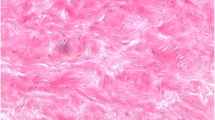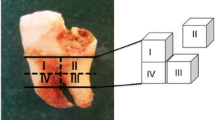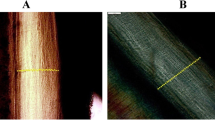Summary
The extent of aspartic acid racemization in total dentin and in dentin protein fractions from theroots of third molars was determined. In several cases coronal dentin was also investigated. The results of other authors, according to which the racemization of aspartic acid in root dentin apparently proceeds differently than in coronal dentin, could be confirmed. Consequently, the data published so far on age determination based on the extent of aspartic acid racemization in coronal dentin and the “entire dentin of longitudinal sections” cannot be applied to root dentin. In total root dentin and the acid soluble protein of root dentin, a close relationship was observed between the extent of aspartic acid racemization and age. Accordingly, estimation of age at death based on aspartic acid racemization in dentin is also possible for root dentin, apparently with good results. This is important particularly in those cases where a large portion of the coronal dentin is absent, for instance following dental treatment. In the investigation of root dentin, regression equations specific for root dentin must be employed in the estimation of age at death. Corresponding equations for third molars were calculated.
Zusammenfassung
Der Razemisierungsgrad von Asparaginsäure wurde in Gesamtdentin sowie in Dentinproteinfraktionen aus Zahnwurzeln dritter Molaren bestimmt, in einigen Fällen wurde zusätzlich Kronendentin mituntersucht. Die Ergebnisse anderer Autoren, nach denen die Razemisierung von Asparaginsäure in Zahnwurzeldentin offenbar anders verläuft als in Kronendentin, konnten bestätigt werden. Damit können die bislang zur Lebensaltersbestimmung aufgrund des Razemisierungsgrades von Asparaginsäure in Dentin veröffentlichten Daten für Kronendentin und “longitudinale Dentinsegmente” nicht ohne weiteres auf Wurzeldentin übertragen werden. Für Gesamtwurzeldentin und das säurelösliche Wurzeldentinprotein ergab sich eine enge Beziehung zwischen dem Razemisierungsgrad von Asparaginsäure dem Lebensalter. Eine Lebensaltersbestimmung aufgrund des Razemisierungsgrades von Asparaginsäure ist danach auch an Wurzeldentin mit offenbar guten Ergebnissen möglich. Dies ist vor allem in Fällen von Bedeutung, in denen beispielsweise nach zahnärztlichen Maßnahmen ein Großteil des Kronendentins fehlt. Wird Wurzeldentin untersucht, müssen speziell für Wurzeldentin etablierte Regressionsgleichungen für eine Lebensaltersbestimmung herangezogen werden. Entsprechende Daten für dritte Molaren wurden erarbeitet.
Similar content being viewed by others
References
Bada JL, Schroeder RA (1972) Racemization of isoleucine in calcareous marine sediments: kinetics and mechanism. Earth Planet Sci Lett 15:1–11
Bada JL, Schroeder RA (1975) Amino acid racemization reactions and their geochemical implications. Naturwissenschaften 62:71–79
Fujii N, Muraoka S, Harada K (1989) Purification and characterization of a protein containing D-aspartic acid in bovine lens. Biochim Biophys Acta 999:239–242
Garner WH, Spector A (1978) Racemization in human lens: evidence of rapid insolubilization of specific polypeptides in cataract formation. Proc Natl Acad Sci USA 75:3618–3620
Helfman PM, Bada JL (1975) Aspartic acid racemization in tooth enamel from living humans. Proc Natl Acad Sci USA 72:2891–2894
Helfman PM, Bada JL (1976) Aspartic acid racemization in dentine as a measure of ageing. Nature 262:279–281
Helfman PM, Bada JL, Shou M-Y (1977) Considerations on the role of aspartic acid racemization in the aging process. Gerontology 23:419–425
Man EH, Sandhouse ME, Burg J, Fisher GH (1983) Accumulation of D-aspartic acid with age in the human brain. Science 220:1407–1408
Masters PM (1983) Stereochemically altered noncollagenous protein from human dentin. Calcif Tissue Int 35:43–47
Masters PM (1985) In vivo decomposition of phosphoserine and serine in noncollagenous protein from human dentin. Calcif Tissue Int 37:236–241
Masters PM, Bada JL, Zigler JS (1977) Aspartic acid racemisation in the human lens during ageing and in cataract formation. Nature 268:71–73
Masters PM, Bada JL, Zigler JS (1978) Aspartic acid racemization in heavy molecular weight crystallins and waterinsoluble protein from normal human lenses and cataracts. Proc Natl Acad Sci USA 75:1204–1208
Muraoka S, Fujii N, Tamanoi I, Harada K (1987) Characterization of a protein containing D-aspartic acid in aged mouse lens. Biochem Biophys Res Comm 146:1432–1438
Ogino T, Ogino H, Nagy B (1985) Application of aspartic acid racemization to forensic odontology: post mortem designation of age of death. Forensic Sci Int 29:259–267
Ohtani S, Yamamoto K (1987) Age estimation using the racemization of aspartic acid in human dentin. Jpn J Leg Med 41:181–190
Ohtani S, Yamamoto K (1990) Estimating age through the amino acid racemization of acid-soluble dentinal peptides. Jpn J Leg Med 44:342–345
Ohtani S, Yamamoto K (1991) Age estimation using the racemization of amino acid in human dentin. J Forensic Sci 36:792–800
Ohtani S, Yamamoto K (1992) Estimation of age from a tooth by means of racemization of an amino acid, especially aspartic acid - comparison of enamel and dentin. J Forensic Sci 37:1061–1067
Ritz S, Schütz HW (1992) Aspartic acid racemization in intervertebral discs as an aid to post mortem estimation of age at death. J Forensic Sci, in press
Ritz S, Schütz H-W, Schwarzer B (1990) The extent of aspartic acid racemization in dentin: a possible method for a more accurate determination of age at death? Z Rechtsmed 103:457–462
Schroeder HE (1976) Orale Strukturbiologie. Thieme, Stuttgart
Smith GG, Williams KM, Wonnacott DM (1978) Factors affecting the rate of racemization of amino acids and their significance to geochronology. J Org Chem 43:1–5
Takagi Y, Veis A (1984) Isolation of phosphophoryn from human dentin organic matrix. Calcif Tissue Int 36:259–265
Tung PS, Domenicucci C, Wasi S, Sodek J (1985) Specific immunohistochemical localization of osteonectin and collagen types I and III in fetal and adult porcine dental tissues. J Histochem Cytochem 33:531–540
Author information
Authors and Affiliations
Rights and permissions
About this article
Cite this article
Ritz, S., Schütz, H.W. & Peper, C. Postmortem estimation of age at death based on aspartic acid racemization in dentin: Its applicability for root dentin. Int J Leg Med 105, 289–293 (1993). https://doi.org/10.1007/BF01370387
Received:
Revised:
Issue Date:
DOI: https://doi.org/10.1007/BF01370387




